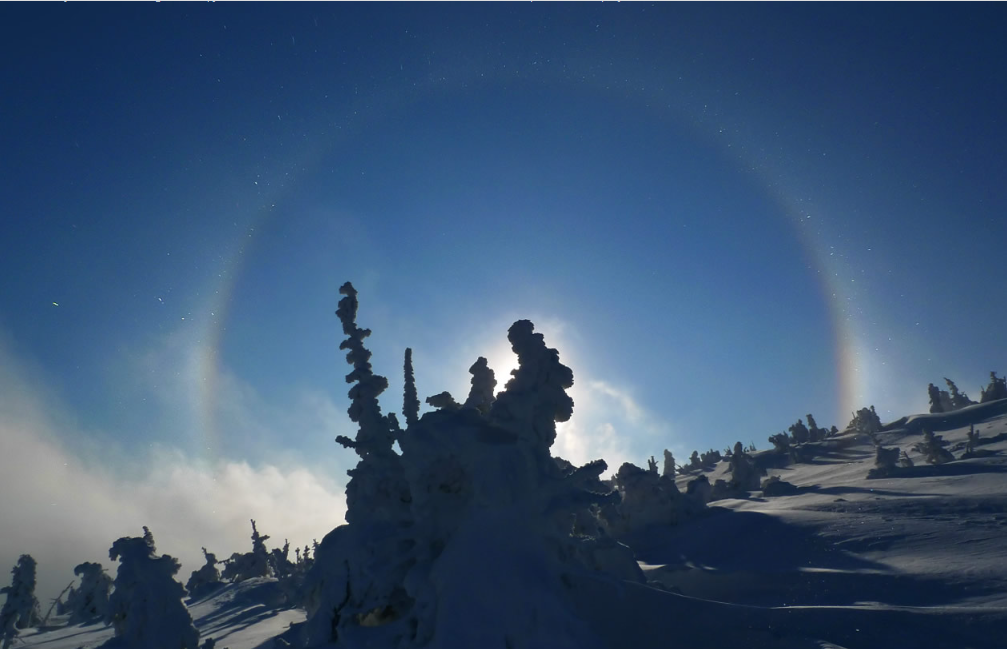OPOD - Diamond Dust, Poland
OPOD - Diamond Dust, Poland: A Captivating Display of Crystal Halos
In the enchanting landscape of the Karkonosze Mountains in Poland, a remarkable atmospheric phenomenon known as diamond dust graced the skies on December 19th. Photographer Radek Grochowski captured the mesmerizing display, where crystals seemed to float nearby, creating a touchable, glinting, sparkling spectacle that adorned the air with swirling patterns and delicate pricks of light. The ethereal beauty of diamond dust lies in its ability to form stunning halos, adding a touch of magic to the wintry landscape.
The first photograph, taken at an altitude of 1400 meters, offers a glimpse into the captivating world of diamond dust. Battling against wind gusts of up to 40 km/h and a temperature of -8 degrees Celsius, Grochowski skillfully zoomed in on the right parhelion and 22° halo. By adjusting the focus close to infinity, the ice crystals appeared off-focus, allowing for a clearer view of individual glint colors. The size of the crystal image served as an indicator of its proximity, revealing the intricate details that make diamond dust so captivating.
Ten minutes prior to the first photograph, a sudden gust of wind lifted myriad ice crystals off the frozen ground, creating a breathtaking halo. The second image captures this ephemeral moment, showcasing individual crystals in the lower right corner, just meters away from the camera. In less than a minute, this part of the display vanished, leaving behind a fleeting memory of its ethereal beauty.
Diamond dust is a rare and enchanting atmospheric optical phenomenon that occurs in cold regions with low humidity. It is composed of tiny ice crystals that hang suspended in the air, creating a magical ambiance as sunlight refracts through them. The resulting glints and sparkles form intricate patterns and halos that dance across the sky, captivating all who witness them.
To fully appreciate the wonder of diamond dust, it is important to understand the science behind it. The ice crystals responsible for this phenomenon are typically plate-shaped or column-shaped, with diameters ranging from 10 to 100 micrometers. These crystals act as prisms, bending and refracting light as it passes through them. This refraction causes the light to separate into its constituent colors, resulting in the vibrant hues and glints that make diamond dust so enchanting.
The formation of diamond dust requires specific atmospheric conditions. It occurs when the temperature is below freezing and there is a source of moisture in the air, such as from nearby bodies of water or from human activities like snowmaking. When these conditions are met, the moisture freezes into tiny ice crystals, which then remain suspended in the air due to weak updrafts or wind currents. As sunlight interacts with these suspended crystals, the mesmerizing display of diamond dust comes to life.
While diamond dust is often associated with cold regions like the polar regions or high-altitude mountain ranges, it can occasionally be observed in other areas with suitable conditions. These captivating displays remind us of the beauty and complexity of our atmosphere, offering a glimpse into the wonders that surround us.
In conclusion, the captivating phenomenon of diamond dust adds a touch of magic to wintry landscapes, creating a spectacle of crystal halos that dance in the air. The images captured by Radek Grochowski in the Karkonosze Mountains, Poland, showcase the enchanting beauty of diamond dust, with glinting ice crystals floating nearby and swirling patterns that seem almost touchable. Understanding the science behind this atmospheric phenomenon allows us to appreciate its rarity and the specific conditions required for its formation. As we marvel at the ethereal beauty of diamond dust, we are reminded of the wonders that exist within our atmosphere and the intricate dance of light and ice crystals that create these mesmerizing displays.

Crystal Halos
Images by Radek Grochowski in the Karkonosze Mountains, Poland, 19th December. ©Radek Grochowski, shown with permission
Diamond dust, crystals afloat nearby, touchable, glinting, sparkling, swirling, pricking the skin, making halos.
“The .top. photo was taken during a hike at an altitude of 1400 meters. The temperature was -8 degrees C with wind gusts up to 40 km/h. The lens was zoomed on the right parhelion and 22° halo. The focus was close to infinity so the ice crystals were generally off-focus. The bigger the crystal image the closer it was.” Off-focus images better show individual glint colours.
The lower picture was ten minutes earlier.. “A wind gust raised myriad ice crystals off the frozen ground and suddenly a beautiful halo appeared. You can clearly see individual crystals, notably those in lower right corner, just a few meters from the camera. In less than a minute this part of the display was over.”

Note: this article has been automatically converted from the old site and may not appear as intended. You can find the original article here.
Reference Atmospheric Optics
If you use any of the definitions, information, or data presented on Atmospheric Optics, please copy the link or reference below to properly credit us as the reference source. Thank you!
-
<a href="https://atoptics.co.uk/blog/opod-diamond-dust-poland/">OPOD - Diamond Dust, Poland</a>
-
"OPOD - Diamond Dust, Poland". Atmospheric Optics. Accessed on November 22, 2024. https://atoptics.co.uk/blog/opod-diamond-dust-poland/.
-
"OPOD - Diamond Dust, Poland". Atmospheric Optics, https://atoptics.co.uk/blog/opod-diamond-dust-poland/. Accessed 22 November, 2024
-
OPOD - Diamond Dust, Poland. Atmospheric Optics. Retrieved from https://atoptics.co.uk/blog/opod-diamond-dust-poland/.